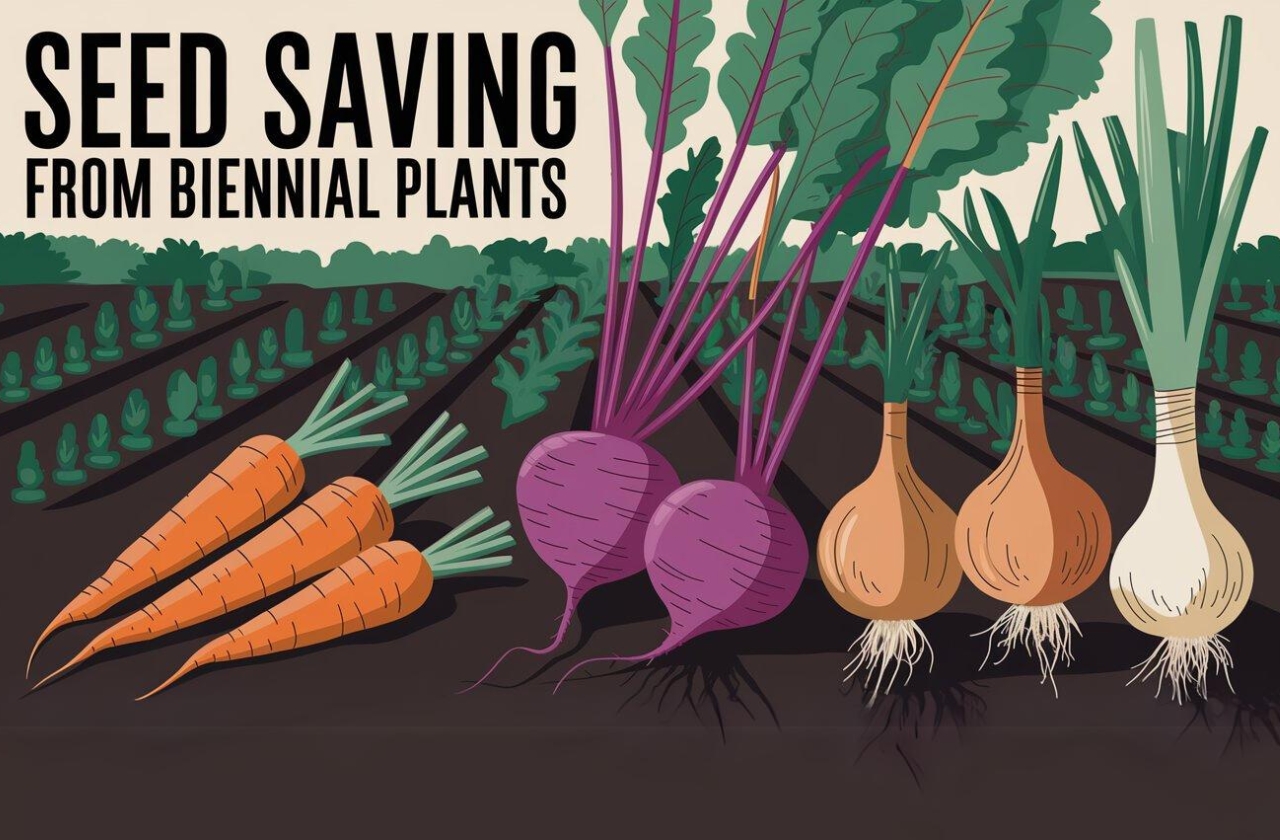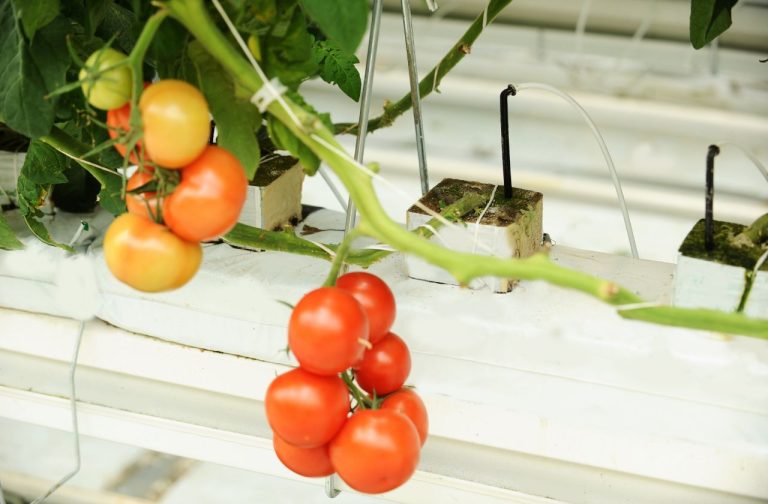Seed Saving From Biennial Plants: Carrots, Beets, and Onions
I get commissions for purchases made through links in this post. View our Affiliate Disclaimer.
As you venture into the world of seed saving, you’ll soon discover that biennials like carrots, beets, and onions require a unique approach. Unlike their annual counterparts, these plants take two growing seasons to complete their life cycle, making the seed saving from biennial plant a more intricate process. By understanding the intricacies of biennial plant life cycles, you’ll reveal the secrets to preserving the genetic diversity and desirable traits of your favorite varieties. But, have you ever wondered what it takes to successfully overwinter biennial vegetables or harvest their seeds at the best time?
Key Takeaways
- Select healthy, robust biennial plants with desirable traits like disease resistance and flavor for seed saving to ensure high-quality seeds.
- Vernalization, a period of cold temperatures, is essential for biennial plants like carrots, beets, and onions to flower and produce seeds.
- Store biennial vegetables in a cool, humid place, protected from freezing and rotting, to ensure survival and thriving in the next growing season.
- Harvest seeds from biennial plants when they are dry and brown, indicating perfect maturity, and process them carefully to preserve genetic diversity.
- Store seeds in a cool, dark place, thoroughly dried and labeled, to prevent moisture damage and preserve seed quality for the next growing season.
Understanding Biennial Plant Life Cycles
When you explore the domain of biennial plants, it’s vital to understand that their life cycle is a two-year journey, with the first year focused on vigorous vegetative growth and the second year dedicated to seed production.
This unique growth cycle allows biennial plants to store energy and develop strong roots, stems, and leaves, preparing them for the reproductive stage. Vernalization, a period of cold temperatures, is essential for biennials to flower and produce seeds in their second year.
You’ll find common biennial crops like carrots, beets, onions, and cabbage exhibiting this two-year growth pattern. To successfully save seeds from biennials, you need to comprehend their life cycle and provide ideal conditions for overwintering.
This involves storing the plants in a way that simulates winter, allowing them to survive the cold and be ready for seed production in the following year. By grasping the fundamentals of biennial plant life cycles, you’ll be better equipped to preserve heirloom varieties and ensure genetic diversity in your home garden through seed saving.

Selecting Healthy Plants for Seed Saving From Biennial Plants
When selecting healthy plants for seed saving, you’ll want to focus on those that exhibit vigorous growth, disease resistance, and desirable traits like flavor and texture.
Prioritizing plants that showcase uniform size, shape, and color is crucial, as these characteristics will directly impact the quality of the seeds you harvest.
Plant Selection Criteria
You’ll want to evaluate your biennial plants carefully, selecting the healthiest and most robust individuals to serve as seed parents. This is important for seed saving, as the quality of your seeds depends on the quality of the plants you choose.
Look for plants that exhibit desirable genetic traits, such as disease resistance, size, and flavor. Avoid plants that show signs of weakness, disease, or poor growth, as these can pass on undesirable traits to future generations.
Consider the overall health and vigor of the plant, as well as its ability to adapt to local growing conditions. By selecting the best plants, you’ll guarantee that your saved seeds will produce strong, resilient plants with desirable characteristics.
Additionally, saving seeds from multiple plants will increase genetic diversity and resilience in the seed stock, making your harvests more sustainable.
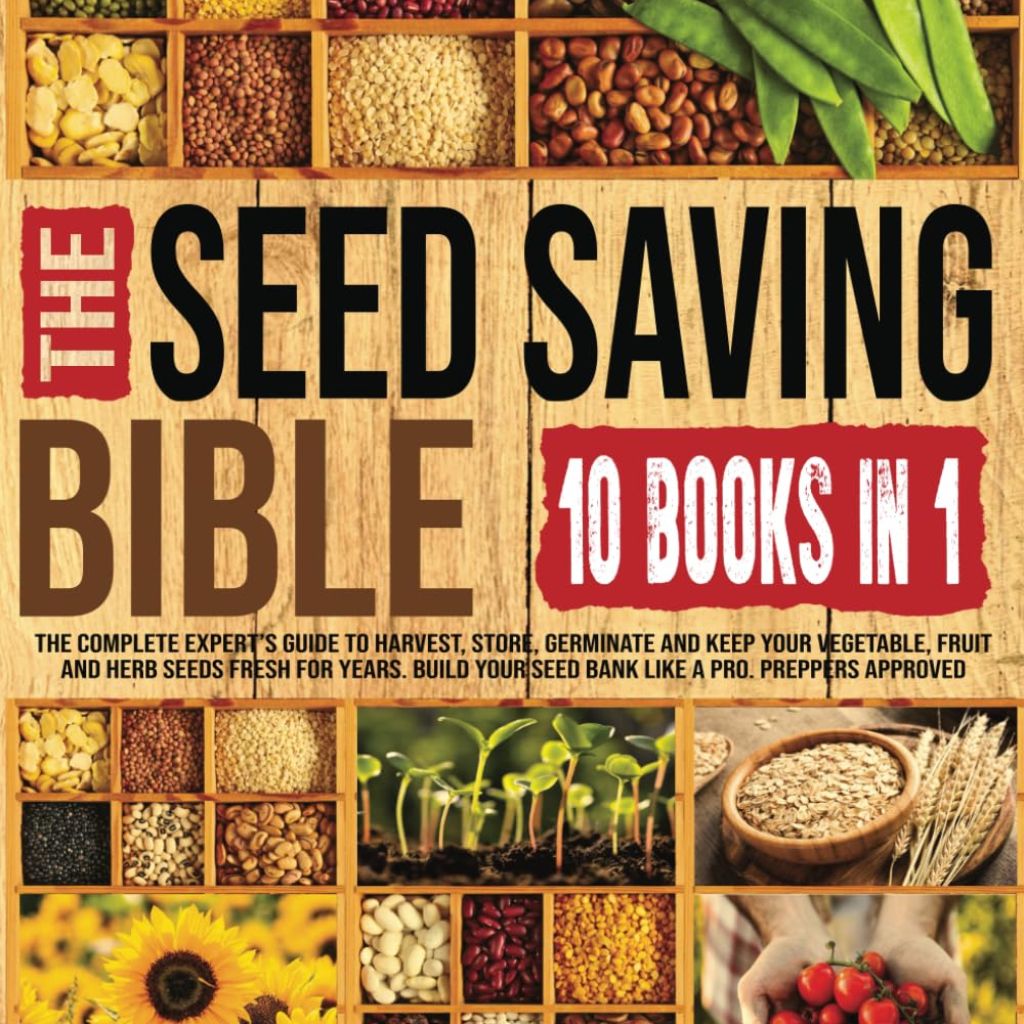
The Seed Saving Bible
The Complete Expert’s Guide To Harvest, Store, Germinate, Keep Your Vegetable And Herb Seeds Fresh For Years

The Seed Garden
The Art and Practice of Seed Saving
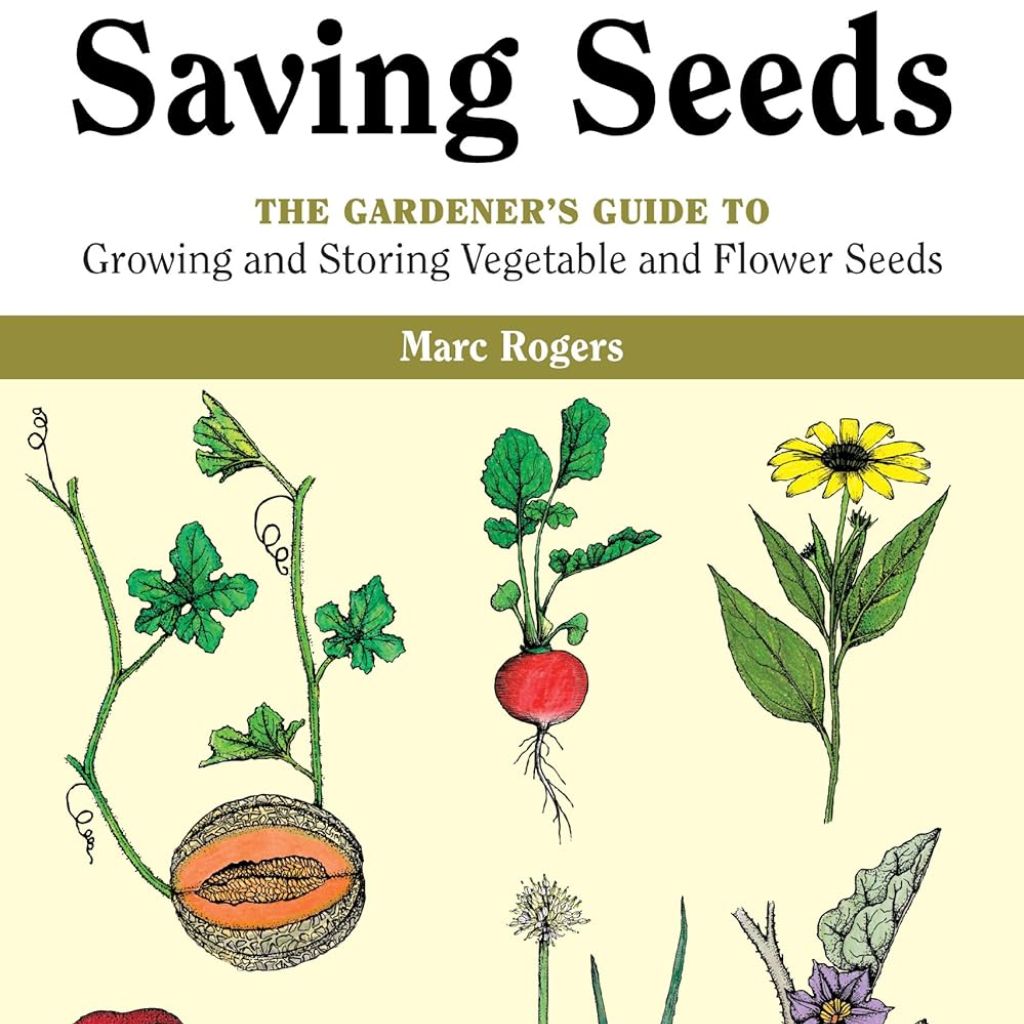
Saving Seeds
The Gardener’s Guide to Growing and Storing Vegetable and Flower Seeds (A Down-to-Earth Gardening Book)
Vigor and Disease Resistance
To guarantee the strongest possible seeds, prioritize biennial plants that boast vigorous growth and robust disease resistance, as these characteristics are essential for producing resilient offspring. By selecting healthy plants for seed saving, you’re ensuring that the genetic traits passed on to future generations will be strong and resilient.
Healthy plants are less likely to succumb to common diseases and pests, making them ideal candidates for seed saving. Vigorous plants are more likely to produce high-quality seeds with better germination rates, leading to successful future crops.
Moreover, disease-resistant plants pass on their immunity to diseases to their offspring, creating stronger and more resilient plant populations.
Flavor and Texture Traits
By prioritizing biennial plants with desirable flavor and texture traits, you can preserve the characteristics that make your carrots, beets, and onions truly exceptional. When selecting plants for seed saving, look for those with the most appealing flavor profiles and textures.
Do you prefer sweet and crunchy carrots, or perhaps beets with a hint of earthy sweetness? Choose plants that exhibit these traits, as they’ll pass them on to future generations. Remember, the quality of your seed saving efforts depends on the genetic integrity of the parent plants.
By selecting plants with desirable flavor and texture traits, you’ll be ensuring that your future crops will retain these characteristics. Healthy, disease-free plants with strong stems and vibrant foliage are more likely to produce high-quality seeds that will germinate well and grow into robust plants.
Overwintering Biennial Vegetables Successfully
Now that you’ve selected healthy biennial plants for seed saving, it’s crucial to guarantee their survival through the winter period.
To do this, you’ll need to take steps to protect them from extreme temperatures, prepare the planting bed properly, and mulch for insulation.
Protecting From Extreme Temperatures
You’ll need to take steps to protect your biennial vegetables from extreme temperatures if you want to successfully overwinter them. When it comes to overwintering biennial vegetables like carrots and beets, storing them in a cool, humid place is key.
Traditional root cellar storage is a great option, where you can store them in sand in bins to maintain their quality during the winter months.
Another approach is to leave hardy vegetables like carrots and beets in the ground, covering them with mulch to insulate them from freezing temperatures and prevent damage.
Alternatively, you can harvest and store root vegetables and cabbages for winter, ensuring they survive cold weather conditions. Whatever method you choose, the goal is to keep your biennials from freezing or rotting, so they can thrive come springtime.
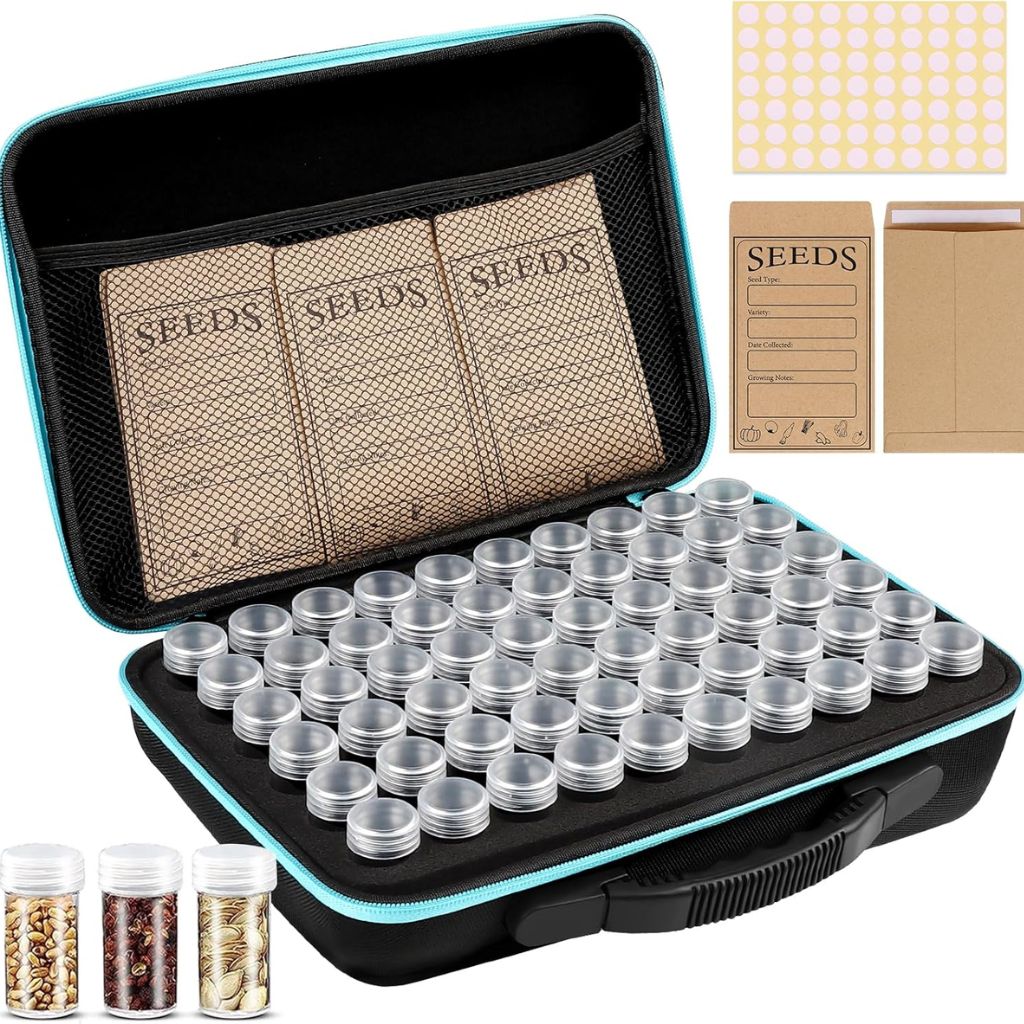
Jixsloft Seed Storage
60 Slots Seed Storage Organizer with 20 Seed Envelopes, Sturdy Seed Organizer Storage Box with Zipper Bag, Label Stickers

Xbopetda Seed Saving Box
Metal Seed Bin, Seed Storage Organizer Box, Seed Packet Container with Lid, Seed Envelope Storage Box, 4 Compartments
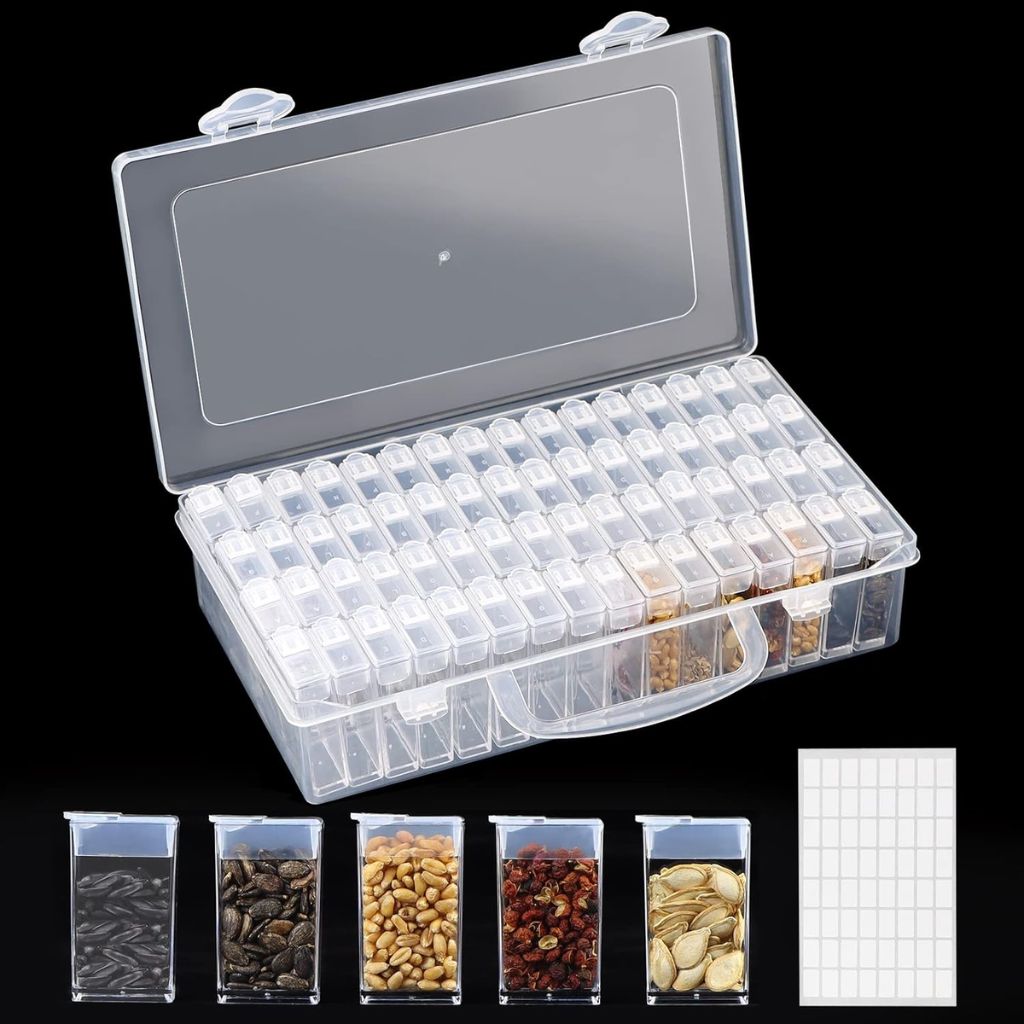
64 Slots Plastic Seed Storage Box
Organizer with Label Stickers(seeds not included), Seed Container Storage use for Flower Seeds,Vegetable Seeds
Preparing the Planting Bed
To guarantee your biennial vegetables survive the winter, prepare the planting bed by clearing it of weeds, rocks, and debris, and enriching the soil with organic matter. This will create a perfect environment for your biennials to thrive during the cold season.
To take your preparation to the next level:
Create raised beds to improve drainage and prevent waterlogging, which can be detrimental during overwintering.
Make sure to maintain proper spacing between plants in the bed to allow for adequate airflow and reduce the risk of diseases that can affect biennial vegetables during the winter months.
Consider adding a layer of mulch or compost to the planting bed to provide insulation and protection for biennial vegetables against freezing temperatures.
Mulching for Insulation
By applying a thick layer of organic mulch, such as straw or leaves, you can effectively insulate your biennial vegetables, like carrots, beets, and onions, against freezing temperatures during the winter months. This vital step in overwintering biennial vegetables successfully guarantees that your plants survive the harsh winter conditions.
Mulching provides insulation, protecting the roots of your carrots, beets, and onions from freezing temperatures and preventing damage. Additionally, it helps maintain soil moisture and prevents rapid temperature fluctuations.
When applying mulch, make sure to do so after the ground has frozen to prevent rodents from nesting in the mulch. Once spring arrives, remove the excess mulch to allow the soil to warm up and your biennial vegetables to resume growth.
Planting and Transplanting Biennials
When planting biennial vegetables like carrots, beets, and onions in the spring after the ground thaws, make sure the top or crown of the plant is at the surface level to support healthy development. This guarantees the plant grows strong and produces quality biennial seeds for saving.
When transplanting, follow these essential steps:
- Water biennial vegetables regularly to maintain soil moisture levels essential for their growth.
- For cabbages, make a small X at the top if the ball is tight to encourage proper growth.
- Transplant small biennial plants back into the garden in the spring after overwintering for seed production.

Preparing for Seed Harvest
You’re now preparing to harvest seeds from your biennial plants, an essential step in seed saving that demands careful planning and attention to detail. To guarantee a successful seed harvest, it’s vital to select the healthiest and best plants for seed saving. This will help maintain desirable traits and preserve the true characteristics of the seeds.
Make sure your biennial plants have experienced vernalization, which triggers seed production. As your plants mature, allow the seeds to fully develop on the plants before harvesting for best viability. Be mindful of cross-pollination, which can alter the genetic makeup of your seeds, and take steps to avoid it.
Biennial Seed Harvesting Techniques
Now that you’ve prepared your biennial plants for seed harvest, it’s time to learn the techniques for collecting and processing the seeds. Harvesting seeds from biennial plants like carrots, beets, and onions requires attention to detail to guarantee ideal maturity and genetic diversity.
When harvesting, keep in mind the following key considerations:
- Harvest seeds in the second growing season when they’re dry and brown, as this indicates perfect maturity.
- Be cautious of different seed maturation rates on the same plant, making sure all seeds are fully mature before harvesting.
- Save seeds from healthy plants with desirable traits to maintain genetic diversity and preserve heirloom varieties.
Storing and Preserving Seeds Properly
To guarantee the seeds you’ve carefully harvested remain viable for the next growing season, store them in properly labeled paper bags or envelopes after thoroughly drying them. This ensures each plant type is stored separately, preventing mixing and ensuring accuracy. Correct storage conditions will have your seeds ready for planting in no time.
| Storage Tip | Description |
|---|---|
| Cool and Dark | Store seeds in a cool, dark place to prevent moisture damage and preserve seed quality. |
| Dry Storage | Use paper bags or envelopes to maintain dryness and prevent moisture damage. |
| Root Cellar | Store seeds in a traditional root cellar using sand in bins to maintain seed quality. |
Troubleshooting Common Seed Saving Issues
After ensuring your seeds are properly stored, it’s time to address common issues that can arise when saving seeds from biennial plants. As you explore seed saving, you’ll likely encounter some obstacles. Don’t worry, with a little investigation, you’ll be on your way to successfully preserving your biennial crops.
Here are some common issues to watch out for:
- Inadequate drying: Failing to dry seeds properly can lead to mold and rot. Make sure to dry your seeds thoroughly before storing them.
- Pest infestation: Check your seeds for signs of damage or pest infestation before storing them for the next season.
- Seed deterioration: Monitor your seeds for signs of deterioration or loss of viability over time.
Frequently Asked Questions
Can You Save Seeds From Hybrid Vegetables?
You take a risk when saving seeds from hybrid vegetables, as they may not retain their quality, leading to genetic drift, patent issues, and inconsistent farming practices, making it wise to avoid breeding methods that compromise your freedom.
What Are the Easiest Vegetables to Save Seed?
You’ll find the easiest veggies to save seeds from are the “Easy Winners” like beans, lettuce, and peas, offering a “Simple Harvest” of pure seeds, perfect for selecting your “Veggie Favorites” and “Garden Staples” to preserve as “Heirloom Treasures”.
How Do You Save Seeds From Vegetables to Plant Next Year?
You’ll successfully save seeds from veggies for next year’s harvest by mastering seed harvesting, controlling moisture, practicing crop rotation, carefully cleaning seeds, and using proper storage methods, all while sharing seeds with your community.
Do Biennials Reseed Themselves?
You’ve likely heard that biennials reseed themselves, but that’s a garden myth. In reality, they don’t spread seeds naturally, unlike their wild ancestors, and require intentional seed saving to preserve their evolutionary history through natural selection and plant breeding.
Conclusion
By saving seeds from biennial plants like carrots, beets, and onions, you’re not only preserving genetic diversity but also ensuring that your future crops inherit desirable traits.
By following the steps outlined above, you’ll be well on your way to harvesting high-quality seeds that will thrive in your garden.
Remember to store them properly, and you’ll be enjoying the fruits of your labor for seasons to come.
Get more posts like this
Subscribe to our mailing list and get interesting homesteading and green living info and updates to your email inbox.
Thank you for subscribing.
Something went wrong.

